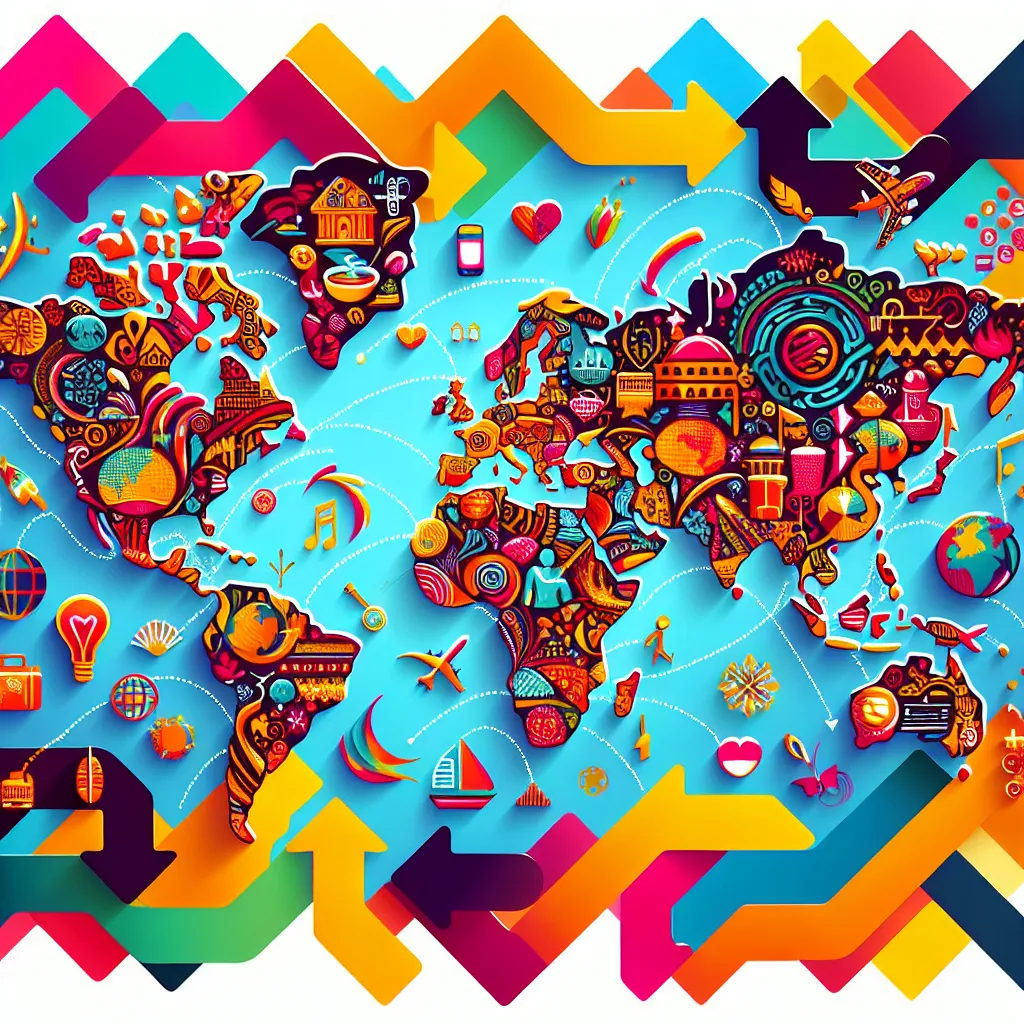In today’s interconnected world, globalization has become a powerful force shaping societies across the globe. This IELTS Reading practice test focuses on the theme “How globalization is influencing local cultures,” exploring various aspects of this complex phenomenon. As you work through this test, you’ll encounter vocabulary and concepts related to cultural exchange, economic integration, and the challenges faced by traditional societies in an increasingly globalized world.
Table Of Contents
- Reading Passage 1
- The Global Village: Bridging Cultures in the Digital Age
- Questions 1-7
- Questions 8-13
- Reading Passage 2
- Economic Globalization and Its Cultural Implications
- Questions 14-19
- Questions 20-26
- Reading Passage 3
- The Dialectic of Global and Local: Rethinking Cultural Identity in the Age of Globalization
- Questions 27-32
- Questions 33-40
- Answer Key
- Reading Passage 1
- Reading Passage 2
- Reading Passage 3
 Globalization Impact on Local Cultures
Globalization Impact on Local Cultures
Reading Passage 1
The Global Village: Bridging Cultures in the Digital Age
In the era of rapid technological advancement and increased connectivity, the concept of a “global village” has become more than just a theoretical construct. The internet and social media platforms have revolutionized the way people interact, share information, and experience different cultures. This digital interconnectedness has led to a unprecedented level of cultural exchange, blurring the lines between local traditions and global trends.
One of the most visible impacts of globalization on local cultures is the spread of popular culture. Hollywood movies, Western music, and international fashion brands have found their way into even the most remote corners of the world. This cultural influx has led to the emergence of hybrid cultural forms, where local traditions blend with global influences to create unique expressions of identity.
However, this cultural exchange is not a one-way street. As local cultures are exposed to global influences, they also contribute to the global cultural tapestry. Ethnic cuisines, traditional arts, and indigenous knowledge are gaining recognition and appreciation on the world stage. This two-way flow of cultural elements has led to a rich and diverse global culture that continues to evolve.
The digital age has also empowered individuals and communities to preserve and promote their cultural heritage. Social media platforms and online repositories allow for the documentation and sharing of traditional practices, languages, and customs that might otherwise be lost to time. This digital preservation of culture has become a crucial tool in maintaining cultural diversity in the face of homogenizing global influences.
Yet, the rapid pace of cultural change brought about by globalization has not been without its challenges. Many communities struggle to maintain their traditional ways of life in the face of modernization and economic pressures. The younger generation, in particular, often finds itself caught between the allure of global culture and the desire to preserve their cultural roots.
As we navigate this new global landscape, it is essential to find a balance between embracing the benefits of global connectivity and preserving the unique aspects of local cultures. The future of our global village depends on our ability to celebrate diversity while fostering understanding and respect across cultural boundaries.
Questions 1-7
Do the following statements agree with the information given in Reading Passage 1? Write
TRUE if the statement agrees with the information
FALSE if the statement contradicts the information
NOT GIVEN if there is no information on this
- The internet and social media have slowed down cultural exchange between nations.
- Hollywood movies and Western music have reached even remote areas of the world.
- Local cultures only receive influences from global trends without contributing anything in return.
- Digital platforms have become important tools for preserving cultural heritage.
- All communities easily adapt to the changes brought by globalization.
- The younger generation universally rejects their cultural roots in favor of global trends.
- Maintaining cultural diversity is crucial for the future of our interconnected world.
Questions 8-13
Complete the sentences below. Choose NO MORE THAN TWO WORDS from the passage for each answer.
- The concept of a __ __ has become a reality due to technological advancements.
- The blending of local traditions and global influences has resulted in __ __ forms of culture.
- __ __ is an example of local cultural elements gaining global recognition.
- Online platforms allow for the __ and sharing of traditional practices and languages.
- Communities face __ __ that make it difficult to maintain traditional lifestyles.
- Finding a __ between global connectivity and local cultural preservation is essential for the future.
Reading Passage 2
Economic Globalization and Its Cultural Implications
The process of economic globalization has been a driving force in reshaping local cultures around the world. As national economies become increasingly interconnected through trade, investment, and the movement of labor, cultural norms and practices are inevitably influenced. This economic integration has brought about both opportunities and challenges for local communities, often leading to significant cultural transformations.
One of the most profound impacts of economic globalization on local cultures is the changing nature of work and lifestyle. Multinational corporations have established operations in diverse locations, bringing with them not only jobs but also corporate cultures that can differ significantly from local traditions. This has led to the adoption of new work practices, dress codes, and even social norms in many communities.
The influx of foreign goods and services has also played a crucial role in altering local consumption patterns and cultural preferences. Traditional markets are increasingly replaced by supermarkets and shopping malls, offering a wide array of international products. This availability of global brands and products has influenced everything from dietary habits to fashion choices, often at the expense of local alternatives.
However, economic globalization has also created opportunities for local cultures to reach global markets. Artisanal crafts, traditional textiles, and indigenous art forms have found new audiences and markets through e-commerce platforms and international trade fairs. This global exposure has, in some cases, led to a renewed appreciation and revival of local cultural practices and products.
The tourism industry, a significant aspect of economic globalization, has had a particularly complex impact on local cultures. While it has brought economic benefits to many communities, it has also led to the commodification of cultural practices and traditions. Festivals, rituals, and traditional performances are often adapted or staged for tourist consumption, raising questions about authenticity and cultural preservation.
Another significant cultural implication of economic globalization is the increasing mobility of people. Labor migration, both within and across national borders, has led to the formation of diverse, multicultural communities in many parts of the world. This mixing of cultures has resulted in new hybrid cultural forms and practices, challenging traditional notions of cultural identity and belonging.
The impact of economic globalization on local languages is also noteworthy. English, as the dominant language of international business, has become increasingly prevalent in many non-English speaking countries. This has led to concerns about the preservation of linguistic diversity and the potential loss of local languages and dialects.
As economic globalization continues to shape our world, it is crucial to consider its cultural implications carefully. While it has undoubtedly brought many benefits, including increased cultural exchange and economic opportunities, it also poses challenges to cultural diversity and local traditions. Finding ways to harness the positive aspects of globalization while mitigating its negative impacts on local cultures remains an important global challenge.
Questions 14-19
Choose the correct letter, A, B, C, or D.
-
According to the passage, economic globalization has:
A) Only positive effects on local cultures
B) Only negative effects on local cultures
C) Both positive and negative effects on local cultures
D) No significant impact on local cultures -
The establishment of multinational corporations in diverse locations has led to:
A) The complete rejection of local traditions
B) The adoption of new work practices and social norms
C) The strengthening of local cultural practices
D) The isolation of local communities from global trends -
The availability of international products in local markets has:
A) Had no effect on local consumption patterns
B) Completely eliminated local products
C) Influenced dietary habits and fashion choices
D) Increased the popularity of local alternatives -
E-commerce platforms and international trade fairs have:
A) Hindered the sale of local cultural products
B) Only benefited large multinational corporations
C) Provided new opportunities for local artisans and craftspeople
D) Had no impact on local cultural practices -
The tourism industry’s impact on local cultures is described as:
A) Entirely positive
B) Entirely negative
C) Complex, with both benefits and challenges
D) Insignificant in the context of globalization -
The increasing prevalence of English in non-English speaking countries has led to:
A) The complete disappearance of local languages
B) Increased linguistic diversity
C) Concerns about the preservation of local languages
D) The rejection of English in business contexts
Questions 20-26
Complete the summary below. Choose NO MORE THAN TWO WORDS from the passage for each answer.
Economic globalization has significantly impacted local cultures worldwide. The establishment of (20) __ __ has introduced new work practices and social norms. The availability of (21) __ __ has changed consumption patterns, often at the expense of local products. However, globalization has also created opportunities for local cultures, with (22) __ __ finding new markets globally. The tourism industry has led to the (23) __ of cultural practices, raising questions about authenticity. (24) __ __ has resulted in the formation of multicultural communities, challenging traditional notions of cultural identity. The dominance of English in international business has raised concerns about (25) __ __ . While economic globalization offers benefits, it also poses challenges to (26) __ __ and local traditions.
Reading Passage 3
The Dialectic of Global and Local: Rethinking Cultural Identity in the Age of Globalization
The relationship between globalization and local cultures is far more nuanced and complex than a simple narrative of homogenization or resistance. Instead, we are witnessing a dynamic process of cultural negotiation and adaptation, where local identities are being reshaped and redefined in response to global influences. This dialectical relationship between the global and the local has given rise to what some scholars term “glocalization” – a phenomenon where global and local cultural elements interact to produce new, hybrid forms of cultural expression.
One of the most significant aspects of this cultural dialectic is the way in which local communities are selectively adopting and adapting global cultural elements to suit their own contexts and needs. This process of cultural hybridization is evident in various domains, from music and art to cuisine and fashion. For instance, the global popularity of hip-hop music has led to the emergence of localized versions that incorporate traditional instruments, languages, and themes, creating unique cultural products that resonate both locally and globally.
The digital revolution has played a crucial role in this process of cultural negotiation. Social media platforms and online communities have become spaces where individuals can explore and express multiple cultural identities simultaneously. This has led to the formation of transnational cultural networks that transcend geographical boundaries, allowing for new forms of cultural affiliation and solidarity based on shared interests rather than traditional markers of identity.
However, the intensification of global cultural flows has also sparked reactions aimed at preserving and revitalizing local cultural traditions. This has manifested in various forms, from the resurgence of indigenous languages and traditional practices to the emergence of nationalist movements that seek to assert cultural distinctiveness in the face of perceived global homogenization. These reactions should not be seen merely as resistance to globalization, but rather as part of the ongoing process of cultural negotiation and identity formation in a globalized world.
The impact of globalization on cultural identity is particularly profound for diaspora communities and transnational migrants. These groups often find themselves navigating multiple cultural contexts simultaneously, leading to the development of complex, hybrid identities that challenge traditional notions of cultural belonging. Their experiences highlight the fluidity and multiplicity of cultural identity in the globalized era, where individuals can maintain connections to multiple cultural traditions while also participating in global cultural trends.
The commodification of culture in the global marketplace presents both opportunities and challenges for local communities. On one hand, it has created new economic opportunities through cultural tourism and the global trade in cultural goods. On the other hand, it has raised concerns about the authenticity and integrity of cultural practices when they are packaged for global consumption. This tension between cultural preservation and commercialization remains a key issue in debates about globalization and local cultures.
Education systems around the world are grappling with the challenge of preparing students for a globalized world while also fostering an appreciation for local cultural heritage. This has led to the development of multicultural and global citizenship education programs that aim to cultivate intercultural competence and a sense of global responsibility alongside an understanding of local cultural traditions.
As we move further into the 21st century, it is clear that the relationship between globalization and local cultures will continue to evolve. The challenge lies in finding ways to harness the creative potential of cultural exchange and hybridization while also ensuring the vitality and diversity of local cultural traditions. This requires a nuanced understanding of cultural processes and a commitment to fostering dialogue and mutual respect across cultural boundaries.
In conclusion, the influence of globalization on local cultures is neither a simple process of homogenization nor one of polarization between the global and the local. Instead, it is a complex, ongoing negotiation that is reshaping cultural identities and practices around the world. As we navigate this new cultural landscape, it is crucial to recognize the value of both cultural diversity and intercultural understanding in building a more inclusive and harmonious global society.
Questions 27-32
Choose the correct letter, A, B, C, or D.
-
The concept of “glocalization” refers to:
A) The complete rejection of global influences by local cultures
B) The total domination of local cultures by global trends
C) The interaction between global and local elements to create new cultural forms
D) The preservation of local cultures in isolation from global influences -
According to the passage, the process of cultural hybridization is:
A) Limited to music and art
B) Rejected by most local communities
C) Evident in various cultural domains
D) Only occurring in Western countries -
The role of digital technology in cultural negotiation is described as:
A) Insignificant
B) Harmful to local cultures
C) Crucial in forming transnational cultural networks
D) Only beneficial for large corporations -
The resurgence of indigenous languages and traditional practices is seen as:
A) A complete rejection of globalization
B) Part of the process of cultural negotiation
C) An obstacle to global cultural exchange
D) A temporary phenomenon with no lasting impact -
The experience of diaspora communities and transnational migrants highlights:
A) The impossibility of maintaining multiple cultural identities
B) The fixed nature of cultural identity
C) The fluidity and multiplicity of cultural identity in the globalized era
D) The need to choose between global and local cultural affiliations -
The commodification of culture in the global marketplace is described as:
A) Entirely beneficial for local communities
B) Completely destructive to local cultures
C) Presenting both opportunities and challenges
D) Having no significant impact on local cultural practices
Questions 33-40
Complete the summary below. Choose NO MORE THAN TWO WORDS from the passage for each answer.
The relationship between globalization and local cultures is characterized by a process of (33) __ __ and adaptation. This has led to the phenomenon of “glocalization,” where global and local elements interact to create new cultural forms. The process of (34) __ __ is evident in various cultural domains, with communities selectively adopting global elements to suit their needs. (35) __ __ have become spaces for expressing multiple cultural identities, leading to transnational cultural networks.
However, there have also been reactions aimed at preserving local traditions, including the resurgence of (36) __ __ . (37) __ __ often develop complex, hybrid identities that challenge traditional notions of cultural belonging. The (38) __ __ in the global marketplace presents both opportunities and challenges for local communities.
Education systems are developing (39) __ __ programs to prepare students for a globalized world while fostering appreciation for local heritage. The ongoing negotiation between global and local influences is reshaping cultural identities worldwide, emphasizing the importance of both (40) __ __ and intercultural understanding in building an inclusive global society.
Answer Key
Reading Passage 1
- FALSE
- TRUE
- FALSE
- TRUE
- FALSE
- NOT GIVEN
- TRUE
- global village
- hybrid cultural
- Ethnic cuisines
- documentation
- economic pressures
- balance
Reading Passage 2
- C
- B
- C
- C
- C
- C
- multinational corporations
- foreign goods
- artisanal crafts
- commodification
- Labor migration
- linguistic diversity
- cultural diversity
Reading Passage 3
- C
- C
- C
- B
- C
- C
- cultural negotiation
- cultural hybridization
- Social media platforms
- indigenous languages
- Diaspora communities
- commodification of culture
- multicultural and global citizenship
- cultural diversity
This IELTS Reading practice test explores the complex relationship between globalization and local cultures. It covers various aspects of this topic, including cultural exchange, economic integration, and the challenges faced by traditional societies in an increasingly interconnected world. By working through these passages and questions, you’ll enhance your reading comprehension skills and expand your vocabulary related to globalization and cultural studies.
For more insights on related topics, you might find these articles helpful:
- The Impact of Globalization on Cultural Identity
- The Benefits and Drawbacks of Globalization
- [How Globalization Affects Cultural Preservation](https://www.ielts.



